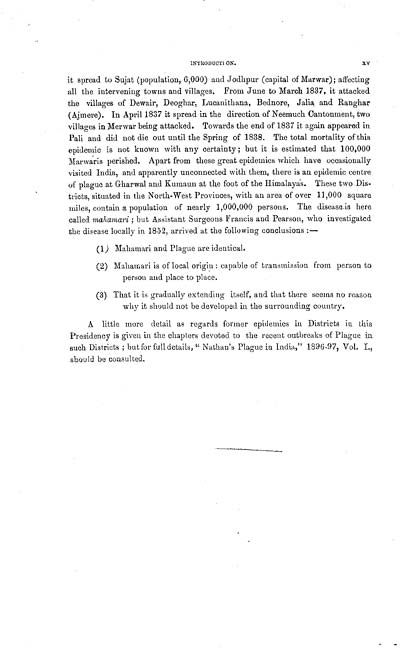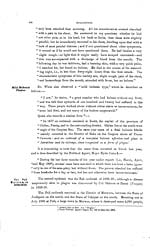Medicine - Disease > Bombay plague: being a history of the progress of plague in the Bombay presidency from September 1896 to June 1899
(18) Page xv
Download files
Individual page:
Thumbnail gallery: Grid view | List view

INTRODUCTION. XV
it spread to Sujat (population, 6,000) and Jodhpur (capital of Marwar); affecting
all the intervening towns and villages. From June to March 1837, it attacked
the villages of Dewair, Deoghar, Lucanithana, Bednore, Jalia and Ranghar
(Ajmere). In April 1837 it spread in the direction of Neemuch Cantonment, two
villages in Merwar being attacked. Towards the end of 1837 it again appeared in
Pali and did not die out until the Spring of 1838. The total mortality of this
epidemic is not known with any certainty ; but it is estimated that 100,000
Marwaris perished. Apart from these great epidemics which have occasionally
visited India, and apparently unconnected with them, there is an epidemic centre
of plague at Grharwal and Kumaun at the foot of the Himalayas. These two Dis-
tricts, situated in the North-West Provinces, with an area of over 11,000 square
miles, contain a population of nearly 1,000,000 persons. The disease is here
called mahamari ; but Assistant Surgeons Francis and Pearson, who investigated
the disease locally in 1852, arrived at the following conclusions :-
(1 ) Mahamari and Plague are identical.
(2) Mahamari is of local origin : capable of transmission from person to
person and place to place.
(3) That it is gradually extending itself, and that there seems no reason
why it should not be developed in the surrounding country.
little more detail as regards former epidemics in Districts in this
Presidency is given in the chapters devoted to the recent outbreaks of Plague in
such Districts ; but for full details, " Nathan's Plague in India," 1896-97, Vol. I.,
should be consulted.
it spread to Sujat (population, 6,000) and Jodhpur (capital of Marwar); affecting
all the intervening towns and villages. From June to March 1837, it attacked
the villages of Dewair, Deoghar, Lucanithana, Bednore, Jalia and Ranghar
(Ajmere). In April 1837 it spread in the direction of Neemuch Cantonment, two
villages in Merwar being attacked. Towards the end of 1837 it again appeared in
Pali and did not die out until the Spring of 1838. The total mortality of this
epidemic is not known with any certainty ; but it is estimated that 100,000
Marwaris perished. Apart from these great epidemics which have occasionally
visited India, and apparently unconnected with them, there is an epidemic centre
of plague at Grharwal and Kumaun at the foot of the Himalayas. These two Dis-
tricts, situated in the North-West Provinces, with an area of over 11,000 square
miles, contain a population of nearly 1,000,000 persons. The disease is here
called mahamari ; but Assistant Surgeons Francis and Pearson, who investigated
the disease locally in 1852, arrived at the following conclusions :-
(1 ) Mahamari and Plague are identical.
(2) Mahamari is of local origin : capable of transmission from person to
person and place to place.
(3) That it is gradually extending itself, and that there seems no reason
why it should not be developed in the surrounding country.
little more detail as regards former epidemics in Districts in this
Presidency is given in the chapters devoted to the recent outbreaks of Plague in
such Districts ; but for full details, " Nathan's Plague in India," 1896-97, Vol. I.,
should be consulted.
Set display mode to: Large image | Zoom image | Transcription
Images and transcriptions on this page, including medium image downloads, may be used under the Creative Commons Attribution 4.0 International Licence unless otherwise stated. ![]()
| India Papers > Medicine - Disease > Bombay plague: being a history of the progress of plague in the Bombay presidency from September 1896 to June 1899 > (18) Page xv |
|---|
| Permanent URL | https://digital.nls.uk/74586004 |
|---|




![Page [xvi]](https://deriv.nls.uk/dcn4/7444/74448524.4.jpg)